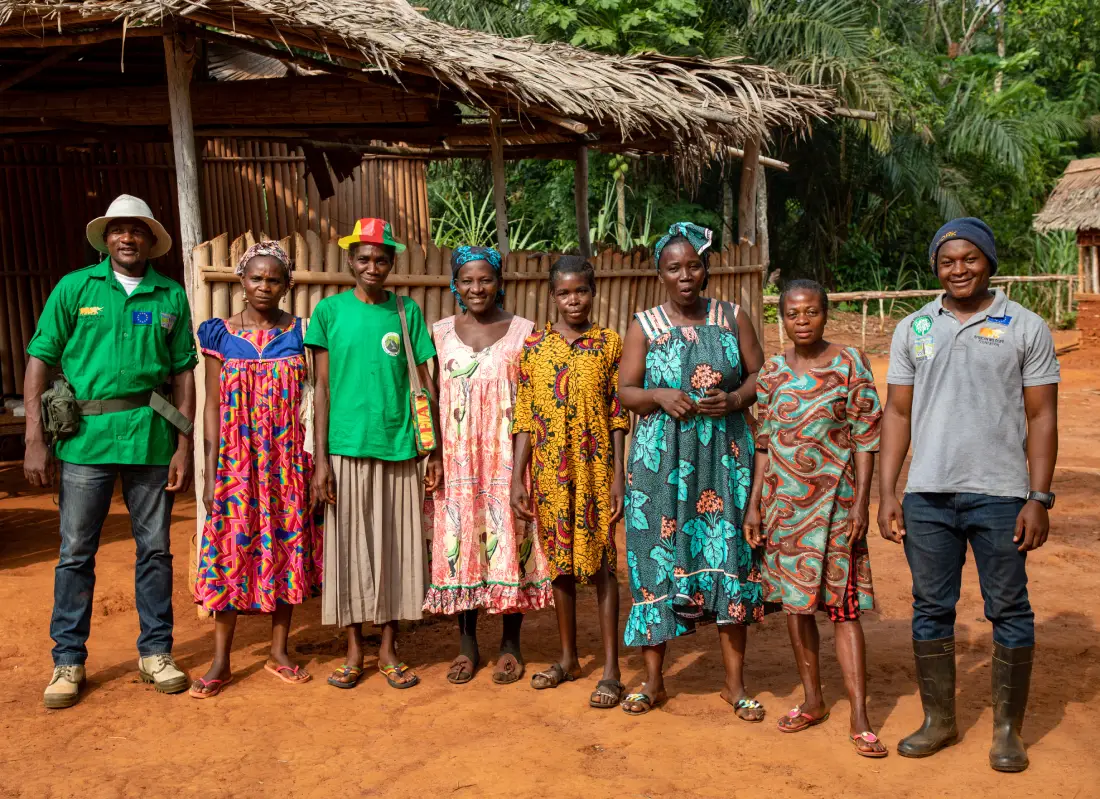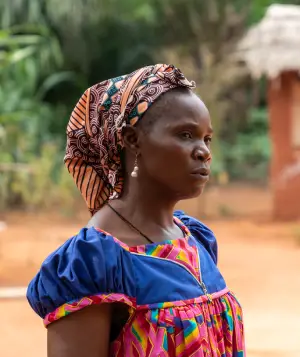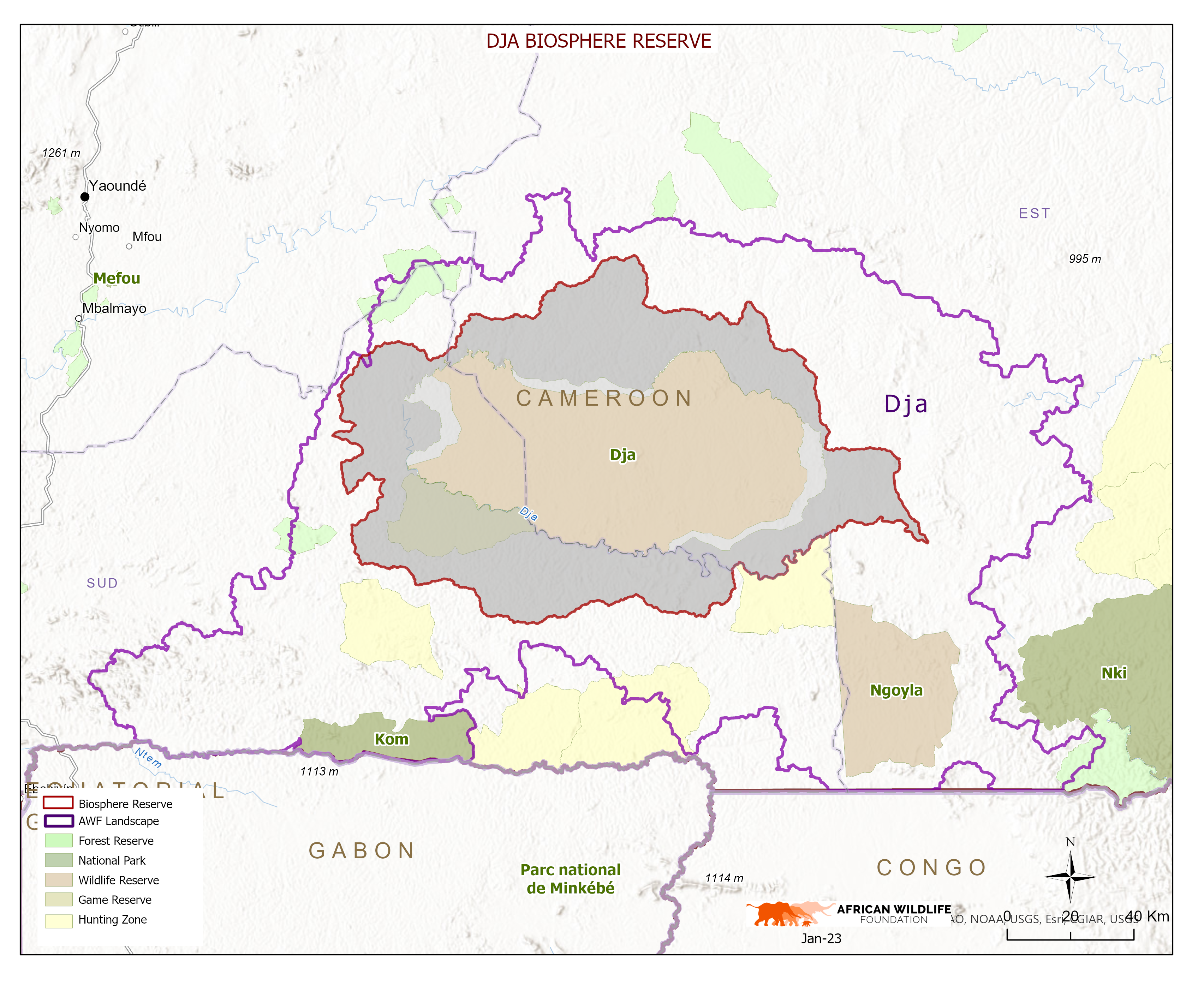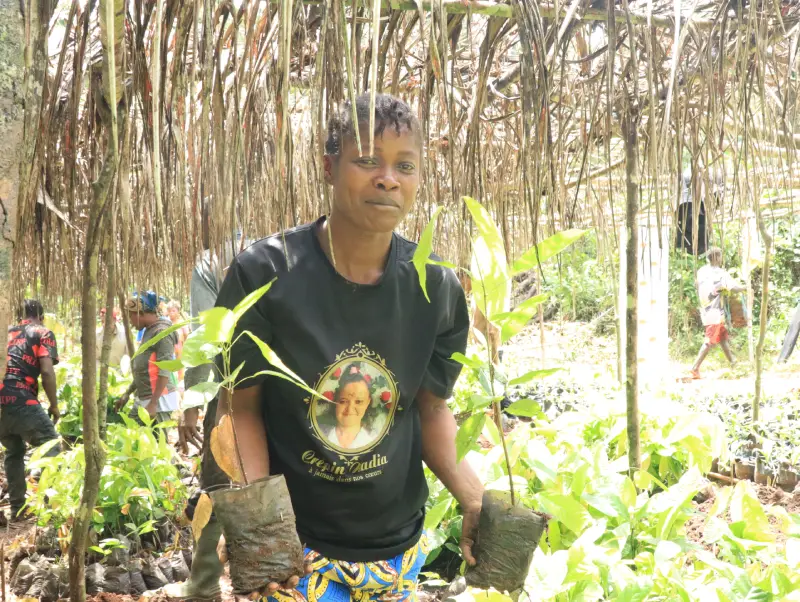AWF's Agroforestry Initiative Empowers Women, Conserves Dja Landscape

VIRGINIE AMBO’O (SECOND LEFT) WITH OTHER WOMEN FROM HER COMMUNITY FROM DJA AFTER RECEIVING COCOA SEEDLINGS DISTRIBUTED BY AWF.
Each morning, Virginie Ambo'o and her sister-in-law, Clautilde Mango'o, walk along a narrow, muddy path through Schouam village in eastern Cameroon, near the Dja Faunal Reserve. With hoes on their shoulders and baskets of machetes, cocoa seedlings, and food on their backs, they make this daily trek to their farms—a routine for many women in the area. This reflects how agriculture sustains both their community and the surrounding landscape.

Virginie Ambo'o, outside her home in Dja.
"I grow cocoa and palm nuts on my farm," Ambo'o shares. "The income from cocoa sales helps me send my six children to school in towns like Bertoua and Yaoundé. I also make soap from the palm nuts for my family and sell any extra for additional income."
While cocoa and palm nuts provide stability for Ambo'o's family, the region’s 129,000 residents across 300 communities rely on diverse livelihoods. These include cultivating cash crops like groundnuts and cocoyams and harvesting non-timber forest products (NTFPs) such as moabi, bush mangoes, Djangsang, and Mbalaka.
The Dja Landscape in southeastern Cameroon encompasses the Dja Faunal Reserve, a critical rainforest ecosystem spanning 526,000 hectares—an area approximately twice the size of metropolitan Paris. Unfortunately, this biodiversity hotspot faces severe threats, including poaching, logging, bushmeat hunting, and infrastructure development.
Since 2018, with support from the European Union, UNESCO, and the Nancy Drapper Foundation, the African Wildlife Foundation (AWF) has partnered with local communities to safeguard Dja's biodiversity. AWF’s holistic conservation approach integrates anti-poaching efforts, sustainable livelihood development, and ecological surveys to inform park management and land-use planning.
AWF’s initiatives particularly empower women through training in sustainable farming and NTFP processing and marketing. By offering alternative income sources, these interventions help reduce dependence on poaching.

Dja Landscape
NTFPs like moabi trees, valued for furniture and flooring, also provide seeds used for cooking oil. Djangsang seeds, known for their nutty, chocolatey flavor, are a staple in West and Central African cuisine and are lauded for their medicinal properties. Mbalaka and bush mangoes serve as essential ingredients in local dishes and traditional remedies, enriching household diets and fueling community markets.
"I gather cocoyam, moabi, Djangsang, and Mbalaka seeds in the forest," Mango'o explains. "At home, I dry and pack them into 50- or 100-kilogram bags to sell to retailers in Yaoundé."
Through partnerships with 22 communities living adjacent to the Dja Faunal Reserve, AWF has introduced sustainable farming practices, significantly improving livelihoods.
"Since 2018, growing cassava, groundnuts, and pepper has helped me care for my four sons," says Albertine Ampopo, a participant in AWF’s agroforestry training. "This year, I collected 250 cocoa plants and plan to start a cocoa farm alongside my other crops. My sons will inherit it when they’re older."
Ampopo recently harvested 300 kilograms of groundnuts, which she plans to sell for between US $3.83 and US $8.62 per kilogram (2,314–5,210 Central African CFA francs). This could yield US $1,149 to US $2,586 (696,294–1,567,116 CFA francs)—a significant income, considering Cameroon’s average annual household income is around US $1,690 (1,042,000 CFA francs).
The five-year EU-funded program, which concluded in 2023, achieved remarkable outcomes, including an 84% reduction in poverty and a 75% increase in income. These successes have also driven a 60% decrease in poaching across the Dja Landscape.

ALBERTINE AMPOPO PICKS COCOA SEEDLINGS DURING A RECENT DISTRIBUTION SUPPORTED BY AWF.
Furthermore, these initiatives have empowered women, granting them greater financial control and decision-making roles in their households and communities.
"My husband listens to me more now," Mango'o shares. "He understands I can contribute to household decisions because I bring in income too." This empowerment fosters a sense of pride and independence among women, who are now recognized as vital to their families’ welfare and conservation efforts.
"The success of this agroforestry initiative is drawing interest from other regions," says Ariane Fondjo, AWF’s community development officer for the Dja Landscape. "The model of combining conservation with community development offers a sustainable blueprint for similar efforts across Africa."
AWF’s integrated conservation approach in the Dja Landscape showcases how sustainable agroforestry strategies create economic opportunities for communities, particularly women, while promoting coexistence and ensuring that both people and wildlife thrive in shared landscapes.